FOOT AND ANKLE BRACING
Foot and Ankle braces provide stability and protection for the foot and ankle– whether used prophylactically, for chronic instability, or following an injury. The design seems to fit into shoes easily, and the breathable material ensures all-day comfort.
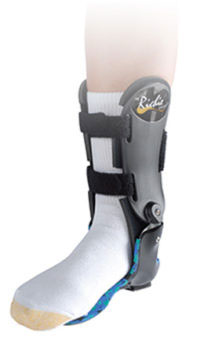
FEATURES
- Custom balanced foot orthotic
- Standard 35mm heel cup fits into the bottom of the heel counter of the shoe
- Anatomic ankle axis hinge placement
- Semi-rigid lower limb supports
- Control of first ray, midtarsal, and subtalar joints
- Control of calcaneal inversion/eversion
- Pure, unrestricted sagittal ankle motion
CLINICAL INDICATIONS
- PTTD (mild-to-moderate)
- Lateral Ankle Instability
- Peroneal tendinopathy
- Cavo-varus deformity
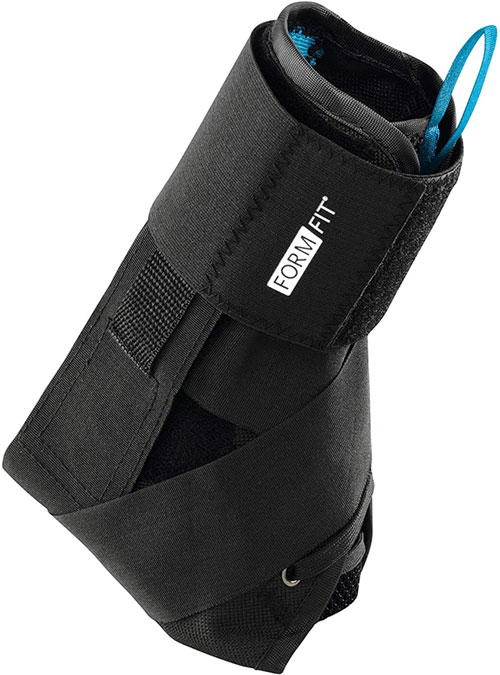
FOOT AND ANKLE BRACE WITH SPEEDLACE
For foot and ankle conditions that may benefit from motion restriction, such as:
- Medical Grade Foot and Ankle Brace Stability – Provides maximum stability & protection to the ankle. Ideal for prophylactic use, chronic instability, & grade I-II sprains.
- Stabilizing Figure 8 Straps – Quick lace-up feature and wrap-around cross straps that limit the further range of movements
- Removable Stays – Semi-rigid removable stays (inserts on either side), quick-pull closure straps, and the circumferential cuff provide more significant support. Can be removed from brace for more flexibility
- Slim-Fit Design – The design fits into shoes easily, and the breathable material ensures all-day comfort. A low-profile design allows you to keep the brace on for longer, providing maximum wearability. It comes in 7 sizes.
- Perfect For Any Sport – The brace supports the ankle in grade I & II sprains for controlled immobilization. Some of these injuries are caused while running, hiking, cycling, or playing strenuous sports like basketball, volleyball, or golf.
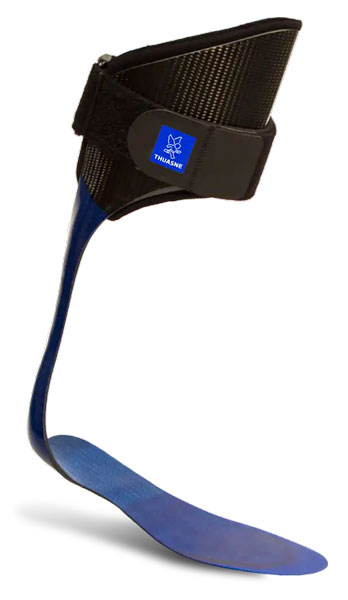
SPRYSTEP® ANKLE BRACE
SpryStep® Ankle Brace is a medical device designed to provide support and stability to the ankle joint. It is commonly used to help prevent or treat injuries, such as sprains or strains, and can also be used to provide support for people with chronic ankle instability or weakness.
The SpryStep® Ankle Brace is made from a breathable, moisture-wicking material that helps to keep the foot and ankle dry and comfortable. It has a low-profile design that fits easily inside most shoes, and it is adjustable to provide a secure and customized fit.
The brace is designed to provide support to the ankle joint while still allowing for a full range of motion. It has padded support on the inside and outside of the ankle to help stabilize the joint and reduce the risk of further injury.
Overall, the SpryStep® Ankle Brace is a useful tool for anyone looking to prevent or treat ankle injuries. Whether you’re an athlete looking to protect yourself from sports-related injuries or just someone who is prone to ankle problems, this brace can help you stay active and comfortable.
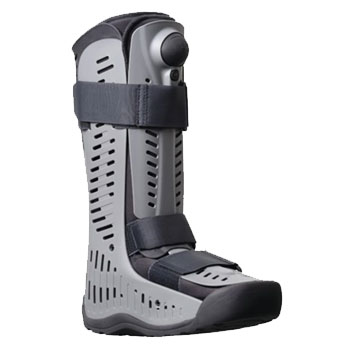
REBOUND AIR WALKER
For foot and ankle conditions that may benefit from motion restriction, such as:
- Grade 2 & 3 ankle sprains
- Stable fractures
- Tendon or ligament sprain
- For postoperative or rehab. If used with Achilles Wedge Kit, Achillles ruptures can be treated as well.
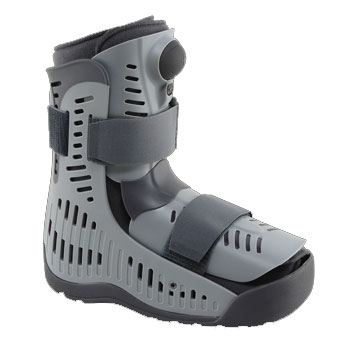
REBOUND AIR WALKER – LOW TOP
For foot and ankle conditions that may benefit from motion restriction, such as:
- Grade 2 & 3 ankle sprains
- Tendon or ligament sprain
- For postoperative or rehab.
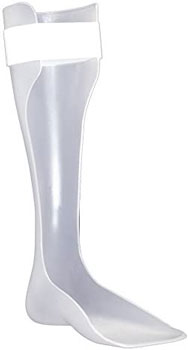
DROP FOOT BRACES
Drop Foot Braces are designed to provide increased dorsiflexion assist and greater medial lateral control during ambulation for those patients suffering neurological deficit resulting in drop foot. The anatomical shape will fit inside most lace-up shoes. It is fabricated from specially formed orthopedic grade thermoplastic and offers durable long term performance and reliability.
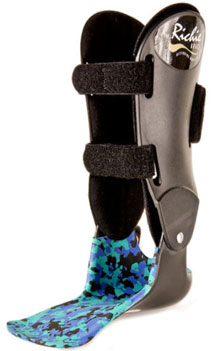
THE RICHIE BRACE®
The Richie Brace® is a revolutionary alternative to traditional ankle-foot orthoses (AFOs). The lightweight construction and low profile design features of the Richie Brace allows better shoe fit, more freedom of movement and reduced pain from injury.
Foot and Ankle Bracing for:
- Drop Foot AFO
- Carbon Fiber AFO
- PTB AFO
- Arizona Brace with or without ankle joint
- Richie Brace with or without ankle joint
- Crow Brace
- AZ Mezzo
- Carbon Fiber/Plastic KAFO
- Any off-the-shelf Bracing
- Walking Boots
Custom Orthotics:
- Carbon Fiber Plate
- Custom Diabetic Insoles and Shoes
- Custom Accommodative/Semi Rigid
- UCBL
- Custom Orthotic with Toe Filler
- Supra-Malleolar Orthotics (SMO)
- and more!
Features and Benefits:
- Soft Flex Edge™ reduces pressure points
- Full rocker bottom is especially engineered to be low and wide to help promote a natural gait
- Stretch-to-fit shell for optimal fit
- Shell can be trimmed for additional stretch in the calf
- Cushioning is breathable
- Linked media/lateral bladders for easy inflation and equal compression
- Integrated pump and air release valve for easy access
Strain vs. Sprain Explained
A strain vs. sprain depends on whether or not muscles, tendons, and or ligaments are stretched or torn. Strains are the more severe version that impacts muscles and tendons (the thick bands that attach muscles to bones). They occur from quick twists, tears, or pulls off the muscle. Pain, weakness, and spasms are common symptoms of this acute injury that results from overstretching or contraction. Bruising is sometimes present, but you can more easily diagnose a strain from pain when contracting or stretching the muscle. MRI can help determine the damage’s extent, proving that rest is required. This may be followed by physical therapy (PT) and strengthening exercises in later healing phases. A doctor or physical therapist can make sound recommendations based on severity. It takes 6-8 weeks to complete the healing process.
Sprains
Sprains affect ligaments (thick bands of cartilage that attach bones to bones) and occur in response to stretches or tears. Injury is often related to a fall or outside force that displaces the joint from its normal alignment. Determine if it’s a Sprains by bruising, swelling, pain with movement, and instability, and most often occur in the ankle, knee, and wrist. There are special tests to determine the ligament affected, and an MRI may be required to determine the extent of the injury. Furthermore, physical therapy and strengthening exercises help support full recovery with surgery needed for the most severe (torn ACL, for example).
Risk Factors
Factors contributing to sprains include:
Environmental conditions.
Slippery or uneven surfaces can make you more prone to injury.
Fatigue.
Tired muscles are less likely to provide good support for your joints.
When you’re tired, you’re more likely to succumb to forces that could stress a joint.
Poor equipment.
Ill-fitting or poorly maintained footwear or other sporting equipment can contribute to your risk of a sprain. Xceed Medical has a great selection of shoes, offering those suffering the relief and comfort needed to get back to living their life.
Prevention
Proper stretching and strengthening for your sport, fitness, or work activity is a great start. In fact, your overall physical conditioning program will minimize your risk of sprains. Try to be in shape to play your sport; don’t play your sport to get in shape. If you have a physically demanding occupation, regular conditioning can help prevent injuries.
You can protect your joints in the long term by working to strengthen and condition the muscles. The best brace you can give yourself is your own “muscle brace.” Ask your doctor about appropriate conditioning and stability exercises. Xceed Medical can help you find the perfect footwear, insoles, compression stockings, and bracing, offering support and protection to help you maintain, heal and recover.
Treatment
Use the RICE method for initial treatment and relief from strains or sprains:
R – REST for 24-48 hours and use crutches or other assistance as necessary to move.
I – ICE the area for 20 minutes every 3-4 hours for the first two days after the injury.
C – COMPRESSION with an ACE bandage or other wrap snuggly, but not to the point of cutting off circulation.
E – ELEVATE above the heart using pillows during sleep to maintain as much as possible.
Always consult with your Dr. before any treatment.

